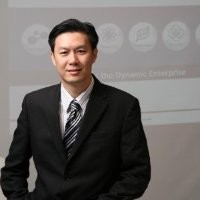Smart technology and Internet of Things (IoT) sensors have become commonplace in everyday life. From the smartwatch on your wrist to the smart meter in our homes, connected devices have become a mainstay in our currently more efficient and sustainable world.
At the city level, rapid urbanization has seen the integration of newer technologies like artificial intelligence (AI), cloud, and also IoT into urban planning to create more connected, safer, and sustainable living.
Singapore, which was recently named the world’s smartest city in 2021 in the Smart City Index, is a prime example. The country’s Smart Nation initiative establishes how technology can create a more efficient and safer environment for citizens while overcoming the frustrations of city living.
No more running to catch the bus
Moving large numbers of people from point to point is a major challenge in urban planning. With the return of pre-pandemic commuter traffic as cities loosen restrictions, buses will become more crowded and roads more congested. For many urban dwellers who need to travel from home to work or school and back daily, commuting can be a stressful and unpleasant experience.
Connected sensors deployed across the city can make up-to-date information easily available to help citizens make travel decisions easier and faster. With more people accessing real-time updates on congestion and overcrowding, traffic can flow more freely as people opt for alternate routes, reducing delays.
For example, Singapore’s Land Transport Authority deployed IoT sensors to collect information in real-time. This information is then used for analysis and planning, and to ease or eliminate heavy traffic congestion as part of the Smart Nation initiative.
This IoT system significantly improved traffic flow with a 92 percent reduction of buses experiencing crowding problems, in addition to a 3 to 7-minute decrease in the average waiting time for buses. In this case, the smart use of IoT technology has tremendously enhanced the living conditions of Singaporeans, where there are over 1 million registered vehicles on the road sharing a small surface area of less than 730 square kilometers.
Additionally, LTA recently implemented the Fusion Analytics for Public Transport Emergency Response (FASTER) system. The FASTER system warns commuters of crowd surges, estimates transport delays and the number of commuters affected in the case of an accident, and even suggests the insertion of new buses and trains when road incidents occur.
Taking out the trash
As cities across the world roar back to life, so do the bothersome inconveniences of city living. From busy queues at rush hour, bins that are constantly overflowing with trash, to broken streetlights that are not fixed for weeks, frustrations can build among city dwellers.
Governmental services that are typically routine can cause frustration. For instance, bins that are emptied on a specific day of the week or streetlights that are only checked when maintenance workers make their rounds often go unnoticed for long periods of time.
However, with the help of smart technology, these issues can easily be resolved. IoT sensors installed on bins, connected to a centrally managed platform, can be programmed to alert services when the container is full. This allows the waste-removal team to only come when needed, reducing unnecessary trips and increasing efficiency.
Flipping the switch
As more countries pledge to keep to their climate change goals, many governments are finding newer, more efficient ways to save energy in all sectors. Recent energy-efficient methods have included subsidized public transport, the construction of green buildings, and electric buses being deployed across Singapore.
Currently, nearly 20 percent of the country’s carbon emissions come from buildings and their associated energy usage. Smart and connected technology can be tapped to help reduce these emissions. Fortunately, such goals are already written into the Singapore Green Building Masterplan, which aims to have 80 percent of buildings in Singapore be green and 80 percent of new infrastructure be Super Low Energy by the year 2030.
Installing IoT sensors in buildings allows organizations to monitor the energy consumption of devices no matter the time or place. With IT teams remotely managing devices from one centralized platform, businesses will be able to save energy consumption and costs without ever having to manually flip the switch.
Smarter technology for a brighter future
The brighter and smarter future is not too far away. Governments and urban planners can now leverage connectivity and smart technologies to build modern cities with services that function more seamlessly, safely, and sustainably. Evidently, in every connected city that is driven by data and information, a reliable, secure, and scalable network is required.
 Kenny Ng is Head of Worldwide Market Development, Network Business Division, Alcatel-Lucent Enterprise.
Kenny Ng is Head of Worldwide Market Development, Network Business Division, Alcatel-Lucent Enterprise.
TechNode Global INSIDER publishes contributions relevant to entrepreneurship and innovation. You may submit your own original or published contributions subject to editorial discretion.

